Analyzing Mental Health Service Delivery: Stefan and Maria's Cases
VerifiedAdded on 2022/10/01
|6
|1457
|163
Report
AI Summary
This report analyzes the Victorian mental health service delivery model through the lens of a case study involving Stefan and his mother, Maria. Stefan, a 23-year-old, exhibits symptoms of a mental health condition, leading to changes in his behavior and a distrust of traditional medical approaches. The report examines Stefan's treatment goals, which include avoiding hospitalization and medication-related weight gain, and Maria's goals, which center on reducing Stefan's aggression and social withdrawal. The analysis explores how the Victorian Mental Health Service Delivery Model, including community care units, prevention and recovery centers, and adult specialist mental health services, can address these needs. The report highlights the suitability of the current system in balancing competing needs and ensuring quality health outcomes, emphasizing the importance of tailored care and family support in the recovery process. The report also references relevant literature on mental health and service delivery models.

Running head: MENTAL HEALTH 1
Mental Health
Name
Institution
Mental Health
Name
Institution
Paraphrase This Document
Need a fresh take? Get an instant paraphrase of this document with our AI Paraphraser
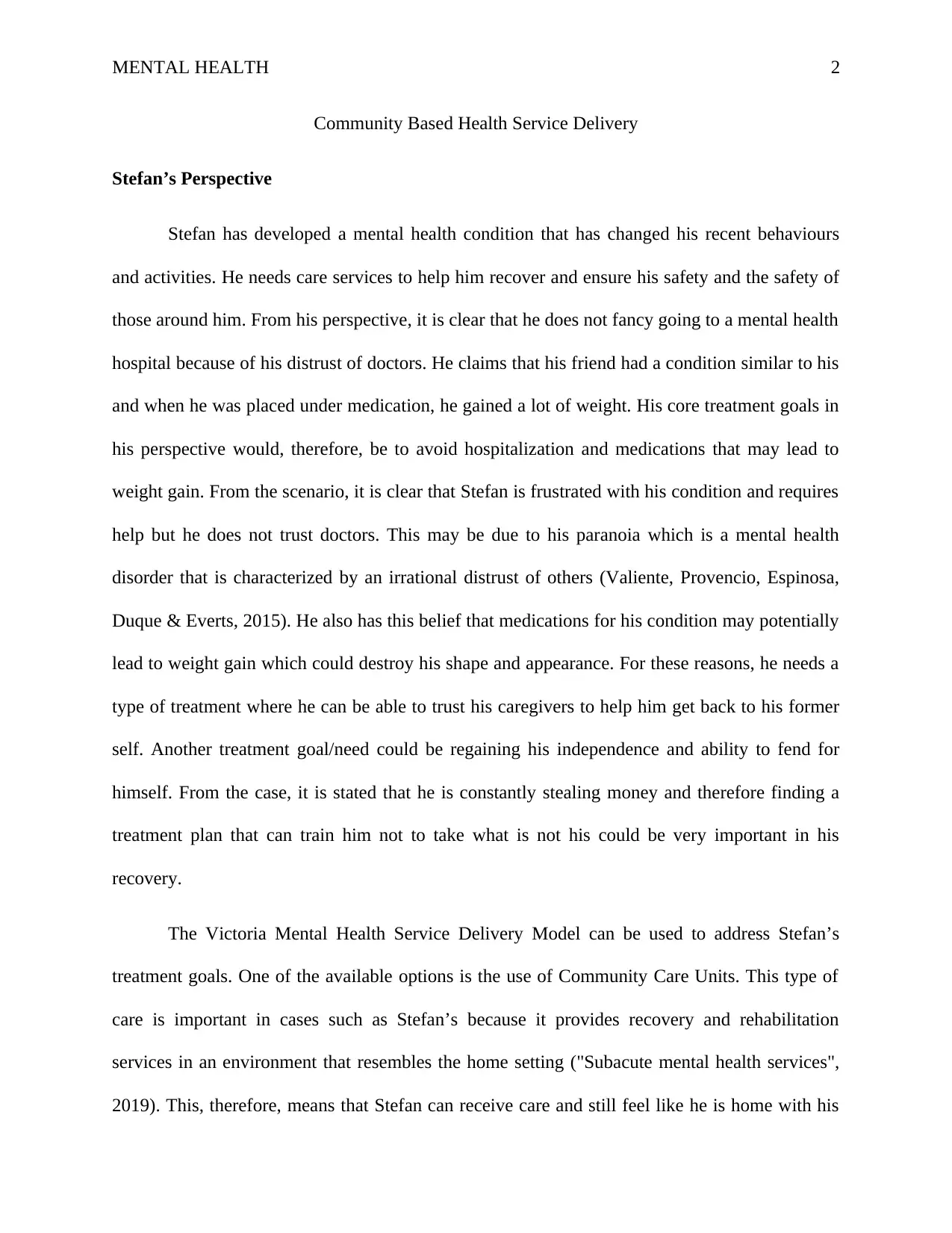
MENTAL HEALTH 2
Community Based Health Service Delivery
Stefan’s Perspective
Stefan has developed a mental health condition that has changed his recent behaviours
and activities. He needs care services to help him recover and ensure his safety and the safety of
those around him. From his perspective, it is clear that he does not fancy going to a mental health
hospital because of his distrust of doctors. He claims that his friend had a condition similar to his
and when he was placed under medication, he gained a lot of weight. His core treatment goals in
his perspective would, therefore, be to avoid hospitalization and medications that may lead to
weight gain. From the scenario, it is clear that Stefan is frustrated with his condition and requires
help but he does not trust doctors. This may be due to his paranoia which is a mental health
disorder that is characterized by an irrational distrust of others (Valiente, Provencio, Espinosa,
Duque & Everts, 2015). He also has this belief that medications for his condition may potentially
lead to weight gain which could destroy his shape and appearance. For these reasons, he needs a
type of treatment where he can be able to trust his caregivers to help him get back to his former
self. Another treatment goal/need could be regaining his independence and ability to fend for
himself. From the case, it is stated that he is constantly stealing money and therefore finding a
treatment plan that can train him not to take what is not his could be very important in his
recovery.
The Victoria Mental Health Service Delivery Model can be used to address Stefan’s
treatment goals. One of the available options is the use of Community Care Units. This type of
care is important in cases such as Stefan’s because it provides recovery and rehabilitation
services in an environment that resembles the home setting ("Subacute mental health services",
2019). This, therefore, means that Stefan can receive care and still feel like he is home with his
Community Based Health Service Delivery
Stefan’s Perspective
Stefan has developed a mental health condition that has changed his recent behaviours
and activities. He needs care services to help him recover and ensure his safety and the safety of
those around him. From his perspective, it is clear that he does not fancy going to a mental health
hospital because of his distrust of doctors. He claims that his friend had a condition similar to his
and when he was placed under medication, he gained a lot of weight. His core treatment goals in
his perspective would, therefore, be to avoid hospitalization and medications that may lead to
weight gain. From the scenario, it is clear that Stefan is frustrated with his condition and requires
help but he does not trust doctors. This may be due to his paranoia which is a mental health
disorder that is characterized by an irrational distrust of others (Valiente, Provencio, Espinosa,
Duque & Everts, 2015). He also has this belief that medications for his condition may potentially
lead to weight gain which could destroy his shape and appearance. For these reasons, he needs a
type of treatment where he can be able to trust his caregivers to help him get back to his former
self. Another treatment goal/need could be regaining his independence and ability to fend for
himself. From the case, it is stated that he is constantly stealing money and therefore finding a
treatment plan that can train him not to take what is not his could be very important in his
recovery.
The Victoria Mental Health Service Delivery Model can be used to address Stefan’s
treatment goals. One of the available options is the use of Community Care Units. This type of
care is important in cases such as Stefan’s because it provides recovery and rehabilitation
services in an environment that resembles the home setting ("Subacute mental health services",
2019). This, therefore, means that Stefan can receive care and still feel like he is home with his
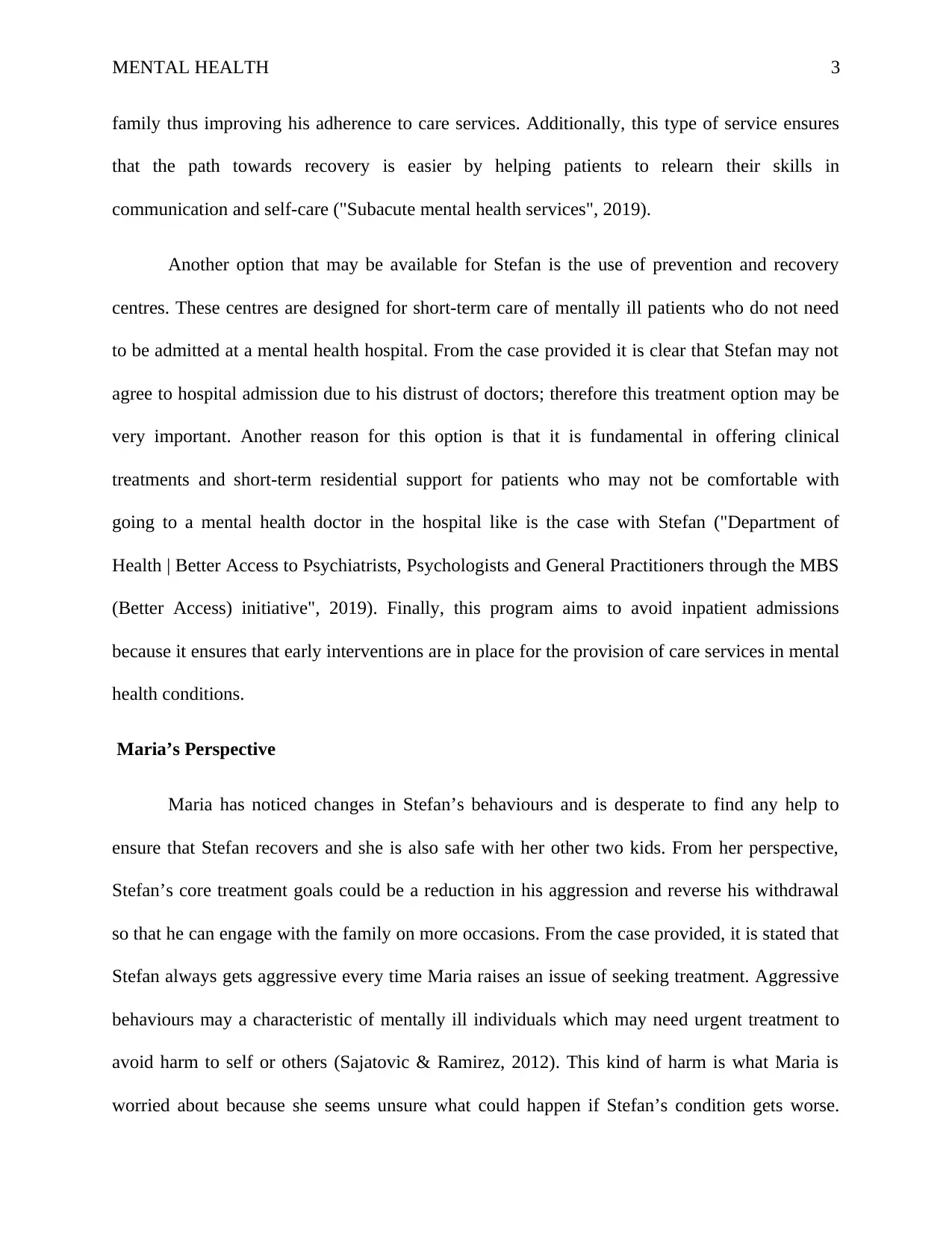
MENTAL HEALTH 3
family thus improving his adherence to care services. Additionally, this type of service ensures
that the path towards recovery is easier by helping patients to relearn their skills in
communication and self-care ("Subacute mental health services", 2019).
Another option that may be available for Stefan is the use of prevention and recovery
centres. These centres are designed for short-term care of mentally ill patients who do not need
to be admitted at a mental health hospital. From the case provided it is clear that Stefan may not
agree to hospital admission due to his distrust of doctors; therefore this treatment option may be
very important. Another reason for this option is that it is fundamental in offering clinical
treatments and short-term residential support for patients who may not be comfortable with
going to a mental health doctor in the hospital like is the case with Stefan ("Department of
Health | Better Access to Psychiatrists, Psychologists and General Practitioners through the MBS
(Better Access) initiative", 2019). Finally, this program aims to avoid inpatient admissions
because it ensures that early interventions are in place for the provision of care services in mental
health conditions.
Maria’s Perspective
Maria has noticed changes in Stefan’s behaviours and is desperate to find any help to
ensure that Stefan recovers and she is also safe with her other two kids. From her perspective,
Stefan’s core treatment goals could be a reduction in his aggression and reverse his withdrawal
so that he can engage with the family on more occasions. From the case provided, it is stated that
Stefan always gets aggressive every time Maria raises an issue of seeking treatment. Aggressive
behaviours may a characteristic of mentally ill individuals which may need urgent treatment to
avoid harm to self or others (Sajatovic & Ramirez, 2012). This kind of harm is what Maria is
worried about because she seems unsure what could happen if Stefan’s condition gets worse.
family thus improving his adherence to care services. Additionally, this type of service ensures
that the path towards recovery is easier by helping patients to relearn their skills in
communication and self-care ("Subacute mental health services", 2019).
Another option that may be available for Stefan is the use of prevention and recovery
centres. These centres are designed for short-term care of mentally ill patients who do not need
to be admitted at a mental health hospital. From the case provided it is clear that Stefan may not
agree to hospital admission due to his distrust of doctors; therefore this treatment option may be
very important. Another reason for this option is that it is fundamental in offering clinical
treatments and short-term residential support for patients who may not be comfortable with
going to a mental health doctor in the hospital like is the case with Stefan ("Department of
Health | Better Access to Psychiatrists, Psychologists and General Practitioners through the MBS
(Better Access) initiative", 2019). Finally, this program aims to avoid inpatient admissions
because it ensures that early interventions are in place for the provision of care services in mental
health conditions.
Maria’s Perspective
Maria has noticed changes in Stefan’s behaviours and is desperate to find any help to
ensure that Stefan recovers and she is also safe with her other two kids. From her perspective,
Stefan’s core treatment goals could be a reduction in his aggression and reverse his withdrawal
so that he can engage with the family on more occasions. From the case provided, it is stated that
Stefan always gets aggressive every time Maria raises an issue of seeking treatment. Aggressive
behaviours may a characteristic of mentally ill individuals which may need urgent treatment to
avoid harm to self or others (Sajatovic & Ramirez, 2012). This kind of harm is what Maria is
worried about because she seems unsure what could happen if Stefan’s condition gets worse.
⊘ This is a preview!⊘
Do you want full access?
Subscribe today to unlock all pages.

Trusted by 1+ million students worldwide
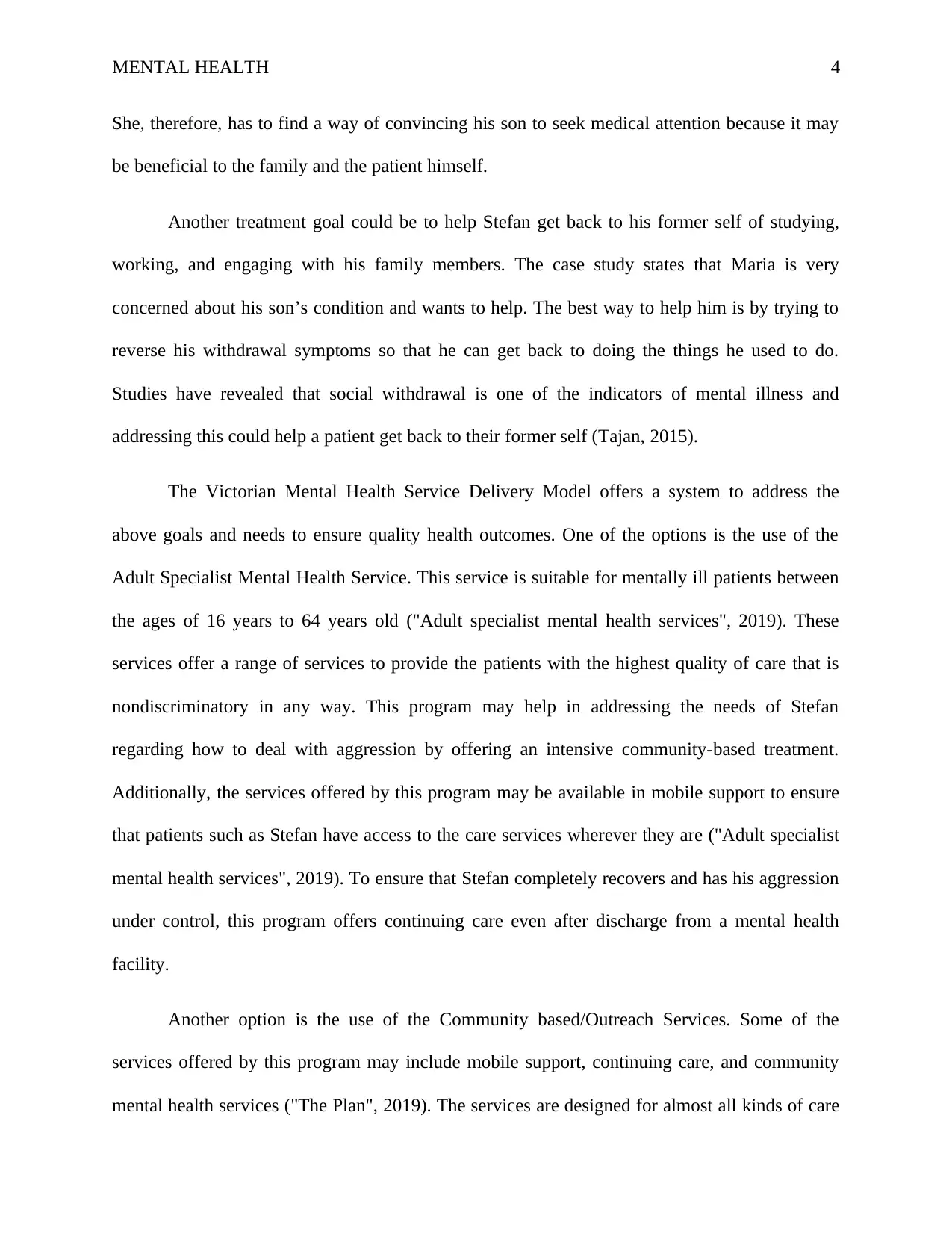
MENTAL HEALTH 4
She, therefore, has to find a way of convincing his son to seek medical attention because it may
be beneficial to the family and the patient himself.
Another treatment goal could be to help Stefan get back to his former self of studying,
working, and engaging with his family members. The case study states that Maria is very
concerned about his son’s condition and wants to help. The best way to help him is by trying to
reverse his withdrawal symptoms so that he can get back to doing the things he used to do.
Studies have revealed that social withdrawal is one of the indicators of mental illness and
addressing this could help a patient get back to their former self (Tajan, 2015).
The Victorian Mental Health Service Delivery Model offers a system to address the
above goals and needs to ensure quality health outcomes. One of the options is the use of the
Adult Specialist Mental Health Service. This service is suitable for mentally ill patients between
the ages of 16 years to 64 years old ("Adult specialist mental health services", 2019). These
services offer a range of services to provide the patients with the highest quality of care that is
nondiscriminatory in any way. This program may help in addressing the needs of Stefan
regarding how to deal with aggression by offering an intensive community-based treatment.
Additionally, the services offered by this program may be available in mobile support to ensure
that patients such as Stefan have access to the care services wherever they are ("Adult specialist
mental health services", 2019). To ensure that Stefan completely recovers and has his aggression
under control, this program offers continuing care even after discharge from a mental health
facility.
Another option is the use of the Community based/Outreach Services. Some of the
services offered by this program may include mobile support, continuing care, and community
mental health services ("The Plan", 2019). The services are designed for almost all kinds of care
She, therefore, has to find a way of convincing his son to seek medical attention because it may
be beneficial to the family and the patient himself.
Another treatment goal could be to help Stefan get back to his former self of studying,
working, and engaging with his family members. The case study states that Maria is very
concerned about his son’s condition and wants to help. The best way to help him is by trying to
reverse his withdrawal symptoms so that he can get back to doing the things he used to do.
Studies have revealed that social withdrawal is one of the indicators of mental illness and
addressing this could help a patient get back to their former self (Tajan, 2015).
The Victorian Mental Health Service Delivery Model offers a system to address the
above goals and needs to ensure quality health outcomes. One of the options is the use of the
Adult Specialist Mental Health Service. This service is suitable for mentally ill patients between
the ages of 16 years to 64 years old ("Adult specialist mental health services", 2019). These
services offer a range of services to provide the patients with the highest quality of care that is
nondiscriminatory in any way. This program may help in addressing the needs of Stefan
regarding how to deal with aggression by offering an intensive community-based treatment.
Additionally, the services offered by this program may be available in mobile support to ensure
that patients such as Stefan have access to the care services wherever they are ("Adult specialist
mental health services", 2019). To ensure that Stefan completely recovers and has his aggression
under control, this program offers continuing care even after discharge from a mental health
facility.
Another option is the use of the Community based/Outreach Services. Some of the
services offered by this program may include mobile support, continuing care, and community
mental health services ("The Plan", 2019). The services are designed for almost all kinds of care
Paraphrase This Document
Need a fresh take? Get an instant paraphrase of this document with our AI Paraphraser
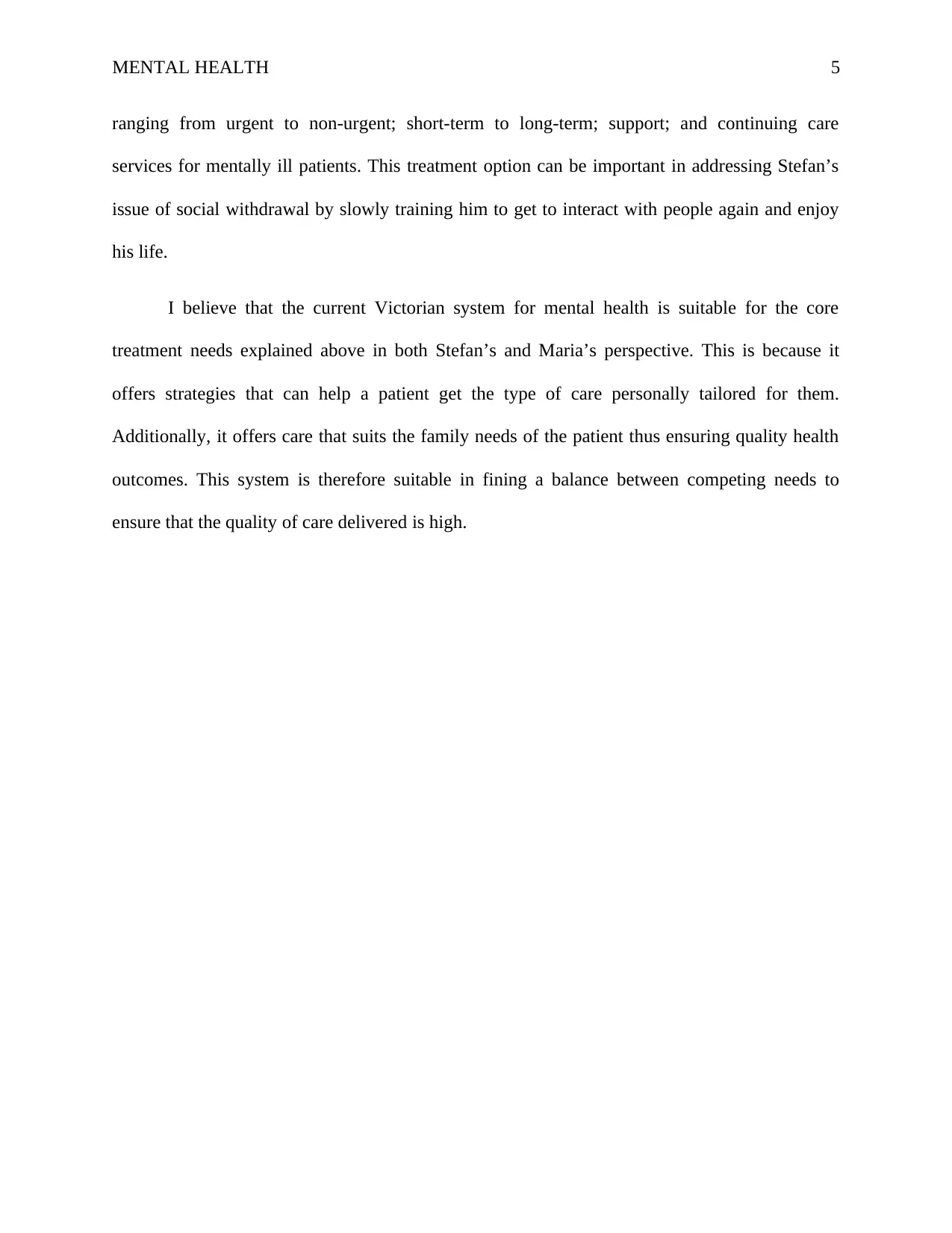
MENTAL HEALTH 5
ranging from urgent to non-urgent; short-term to long-term; support; and continuing care
services for mentally ill patients. This treatment option can be important in addressing Stefan’s
issue of social withdrawal by slowly training him to get to interact with people again and enjoy
his life.
I believe that the current Victorian system for mental health is suitable for the core
treatment needs explained above in both Stefan’s and Maria’s perspective. This is because it
offers strategies that can help a patient get the type of care personally tailored for them.
Additionally, it offers care that suits the family needs of the patient thus ensuring quality health
outcomes. This system is therefore suitable in fining a balance between competing needs to
ensure that the quality of care delivered is high.
ranging from urgent to non-urgent; short-term to long-term; support; and continuing care
services for mentally ill patients. This treatment option can be important in addressing Stefan’s
issue of social withdrawal by slowly training him to get to interact with people again and enjoy
his life.
I believe that the current Victorian system for mental health is suitable for the core
treatment needs explained above in both Stefan’s and Maria’s perspective. This is because it
offers strategies that can help a patient get the type of care personally tailored for them.
Additionally, it offers care that suits the family needs of the patient thus ensuring quality health
outcomes. This system is therefore suitable in fining a balance between competing needs to
ensure that the quality of care delivered is high.
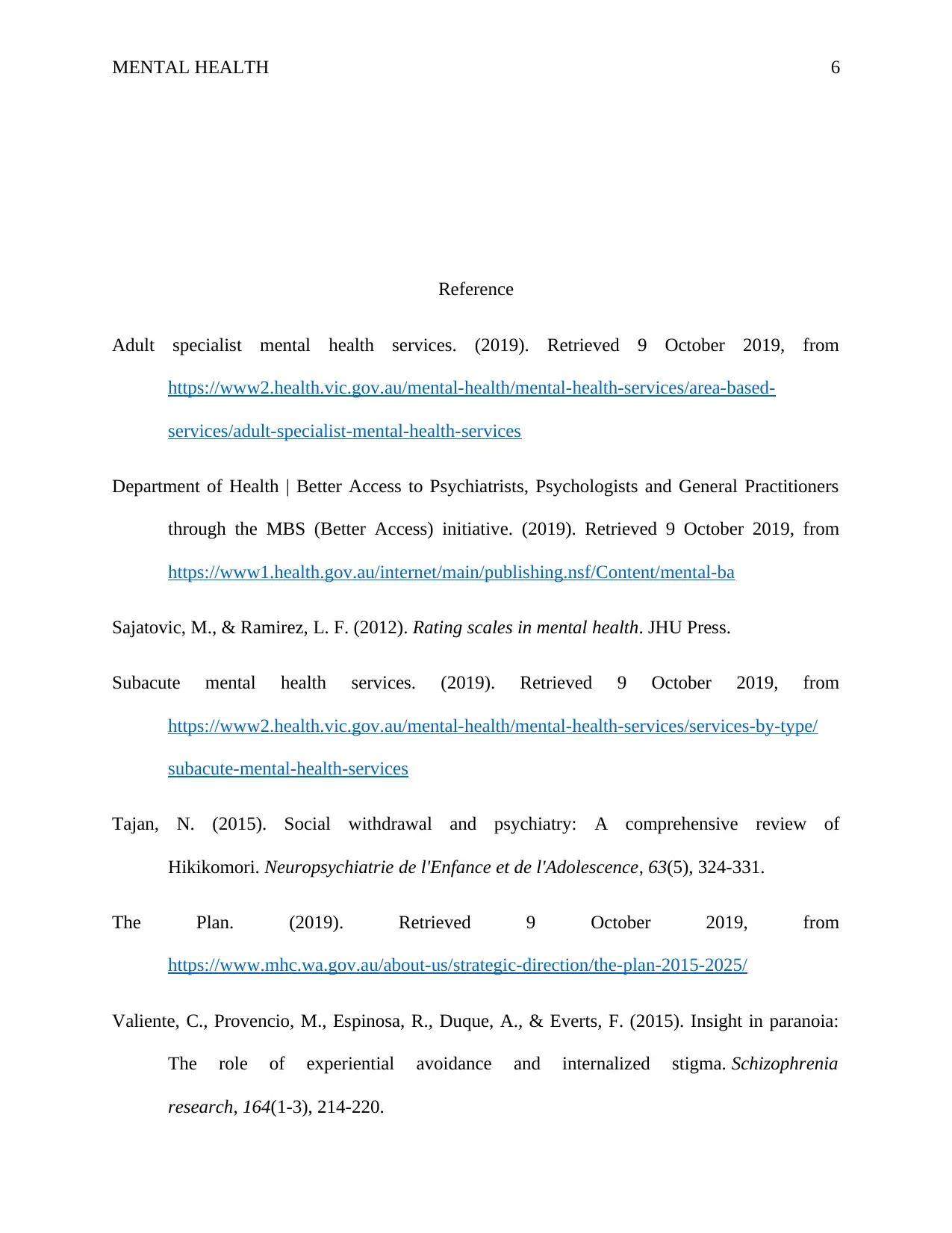
MENTAL HEALTH 6
Reference
Adult specialist mental health services. (2019). Retrieved 9 October 2019, from
https://www2.health.vic.gov.au/mental-health/mental-health-services/area-based-
services/adult-specialist-mental-health-services
Department of Health | Better Access to Psychiatrists, Psychologists and General Practitioners
through the MBS (Better Access) initiative. (2019). Retrieved 9 October 2019, from
https://www1.health.gov.au/internet/main/publishing.nsf/Content/mental-ba
Sajatovic, M., & Ramirez, L. F. (2012). Rating scales in mental health. JHU Press.
Subacute mental health services. (2019). Retrieved 9 October 2019, from
https://www2.health.vic.gov.au/mental-health/mental-health-services/services-by-type/
subacute-mental-health-services
Tajan, N. (2015). Social withdrawal and psychiatry: A comprehensive review of
Hikikomori. Neuropsychiatrie de l'Enfance et de l'Adolescence, 63(5), 324-331.
The Plan. (2019). Retrieved 9 October 2019, from
https://www.mhc.wa.gov.au/about-us/strategic-direction/the-plan-2015-2025/
Valiente, C., Provencio, M., Espinosa, R., Duque, A., & Everts, F. (2015). Insight in paranoia:
The role of experiential avoidance and internalized stigma. Schizophrenia
research, 164(1-3), 214-220.
Reference
Adult specialist mental health services. (2019). Retrieved 9 October 2019, from
https://www2.health.vic.gov.au/mental-health/mental-health-services/area-based-
services/adult-specialist-mental-health-services
Department of Health | Better Access to Psychiatrists, Psychologists and General Practitioners
through the MBS (Better Access) initiative. (2019). Retrieved 9 October 2019, from
https://www1.health.gov.au/internet/main/publishing.nsf/Content/mental-ba
Sajatovic, M., & Ramirez, L. F. (2012). Rating scales in mental health. JHU Press.
Subacute mental health services. (2019). Retrieved 9 October 2019, from
https://www2.health.vic.gov.au/mental-health/mental-health-services/services-by-type/
subacute-mental-health-services
Tajan, N. (2015). Social withdrawal and psychiatry: A comprehensive review of
Hikikomori. Neuropsychiatrie de l'Enfance et de l'Adolescence, 63(5), 324-331.
The Plan. (2019). Retrieved 9 October 2019, from
https://www.mhc.wa.gov.au/about-us/strategic-direction/the-plan-2015-2025/
Valiente, C., Provencio, M., Espinosa, R., Duque, A., & Everts, F. (2015). Insight in paranoia:
The role of experiential avoidance and internalized stigma. Schizophrenia
research, 164(1-3), 214-220.
⊘ This is a preview!⊘
Do you want full access?
Subscribe today to unlock all pages.

Trusted by 1+ million students worldwide
1 out of 6
Related Documents
Your All-in-One AI-Powered Toolkit for Academic Success.
+13062052269
info@desklib.com
Available 24*7 on WhatsApp / Email
![[object Object]](/_next/static/media/star-bottom.7253800d.svg)
Unlock your academic potential
Copyright © 2020–2025 A2Z Services. All Rights Reserved. Developed and managed by ZUCOL.




